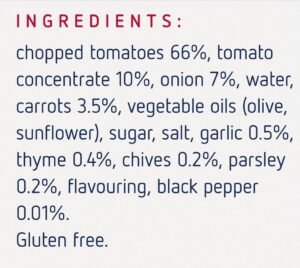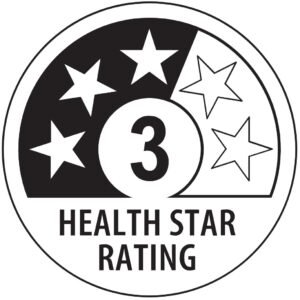How To Understand Food Labels

Food labels can be confusing and hard to understand. In today’s fast-paced world, food shopping is often a rushed chore. This can leave little time to compare food products. However, knowing how to understand food labels and what information to look for can help you make more healthful choices and shopping a breeze!
All food sold in Australia must be labelled as set by the Food Standards Codes [1]. These codes are set by Food Standards Australia and New Zealand (FSANZ for short), which is the governing body in Australia for nutrition labelling [1].
In this post, we will be covering the most common things you will find on food labels:
- Nutrition Information Panel
- Ingredients List
- Health Star Rating
- Health Claims
Nutrition Information Panels
A nutrition information panel show us the amount of nutrients in a food product. This information can help us make choices about the foods we eat. The nutrition information panel must list the amount of energy (kilojoules), fat (as well as saturated fat), carbohydrates, sugar, protein, and sodium (salt) in a food product by law [2]. Some nutrition information panels may also list other nutrients such as fibre, calcium, potassium, etc. (more about this further down). These nutrients are split into two columns, per serve and per 100g/ml [2].
Nutrition information panels also allow us to compare the nutrients of similar food products (e.g. comparing one yoghurt to another). Food products can have very different serving sizes, which makes comparing nutrients per serve much harder (this forces us to do math – and no one wants to do math in a supermarket!). It is much easier to use the ‘per 100g/ml’, as this means we don’t need to do math to compare nutrients. However, if you are looking at fibre, then you should swap to per serve, not per 100g. When comparing food products, you want to look at the whole picture, not just one nutrient. It must be noted that this system was not designed to compare different types of food (e.g. comparing ham to cookies).
The image below provides a great guide of what to look for when reading nutrition information panels. For most people, healthier options are foods that are lower in saturated fat, sugar, salt/sodium (per 100g) and higher in fibre (per serve).

Some nutrition information panels may show a percentage (as seen in the picture to the right). These numbers show how much a serving of a food product meets the daily nutrients needs of an average adult [3]. You may have seen something like this on a food label: *Percentages Daily Intakes are based on an average adult diet of 8,700 kilojoules (kJ). Looking at the image to the right, you can see that one serve of this flour gives 8% of the daily energy needs for an average adult. However, these numbers should only be used as a rough guide, as your nutrition needs may be different [3].

These days, the nutrition information panels for most food products can be found online. Most grocery stores now show them on their websites (for the majority of food products). Beware of errors, as sometimes the numbers online do not always match what is on the package. Looking at nutrition information panels from home is a great way to compare food products. This can help you make a list and speed up your food shopping!
Ingredients List

Every food label in Australia must include an ingredients list by law [4]. All the ingredients used to make the food product are listed by weight, from highest to lowest [4]. The first ingredient has the highest weight proportion, and the last ingredient has the lowest weight [4]. For example, the first ingredient in the image to the left is chopped tomatoes, which equals 66% of the food product. So, it’s fair to say that this food product has a large amount of tomato in it. All known allergens must also be written in the ingredients list.
On food labels, you may sometimes see compound ingredients. These are ingredients made up of two or more foods [4]. For example, the picture on the right shows the first ingredient called ‘vegetable oils’ followed by more ingredients in brackets. This label shows that ‘vegetable oils’ is the compound ingredient, as it is made up of olive and sunflower oil. By law, all ingredients used to make a compound ingredient must be included in the ingredients list unless it makes up less than 5% of the final food product [4]. For example, a tomato sauce (made from tomatoes, onions, garlic, water, and herbs) may not be listed as a compound ingredient if it makes up less than 5% of a frozen pizza.

You may also notice some numbers in the ingredients list. Each number represents a food additive, which must be included in an ingredients list on packaged foods by law [5]. However, if the food additive makes up less than 5% of a compound ingredient or the food comes in a small package (less than 100cm2), then they do not need to be listed [5]. You can read more about food additives here: https://www.foodstandards.gov.au/consumer/labelling/Labelling-of-food-additives
Health Star Rating

If you live in Australia, chances are you are familiar with the Health Star Rating. The Health Star Rating is found on the front of food packages [3]. It gives a star rating based on how healthy the food product is (5 stars being the highest, and ½ a star the lowest) [3]. Additionally, the Health Star Rating could include details on specific nutrients in the food. [3]. The rating is calculated based on the amount of nutrients (such as energy, saturated fat, sodium, total sugars, protein, and dietary fibre) and the ingredients used in the food product [6]. This system was made to help people compare similar food products at a glance and make healthier choices [7].
The Health Star Rating is not used on all food products, as food companies are not forced to use this system by law [7]. Reasons for this may include the cost of making new packaging, and a low Health Star Rating may affect people’s views of the food product. The rating is created using a calculator that can be downloaded [8]. This system also relies on being given the correct information [7]. However, it is the food company’s responsibility to put the information into the calculator to make the Health Star Rating for their products [7]. When in doubt, your best bet is to check the nutrition information panel on the food product.
Health Claims
Claims are statements made by food companies that can be put on food labels [9]. There are two types of claims: nutrition content claims and health claims [9]. These statements may also be used to market food products [9].
Nutrition content claims are about the amount of specific nutrients or substances in foods [9]. Common nutrition content claims you may have seen are ‘low fat’, ‘reduced salt’ or ‘high fibre’ [3].
Health claims, on the other hand, are about the link between a food, nutrient or substance in a food and a health effect [3]. These claims must use information backed by science from research studies and cannot be used for food products that are high in saturated fat, salt, or sugar [9]. There are two different types of health claims that food companies can make:
- General – These are claims about a food, nutrient or substance in food and its effect on health. E.g. ‘Calcium is good for healthy bones‘ [9]
- High Level – Are claims about a nutrient or substance in a food and its link with a serious disease or a marker of a serious disease. E.g.’ A diet high in calcium may help reduce the risk of osteoporosis’ [9]
However, deciding whether a food product is healthy should not be made on the health claim alone. Always look at the nutrition information panel to help guide your choices.
You can read more information about health claims here: https://www.legislation.gov.au/F2015L00394/latest/versions
References
- Food Standards Australia and New Zealand, Labelling. Food Standards Australia and New Zealand; 2023. Available from: [Link]
- Food Standards Australia and New Zealand, Nutrition information panels. Food Standards Australia and New Zealand; 2023. Available from: [Link]
- Australian Government. How to understand food labels. Eat for Health; n.d. Available from: [Link]
- Food Standards Australia and New Zealand. Ingredients list and percentage labelling. Food Standards Australia and New Zealand; 2023. Available from: [Link]
- Food Standards Australia and New Zealand. Food additive labelling. Food Standards Australia and New Zealand; 2023. Available from: [Link]
- Health Star Rating. Health Star Rating system: Calculator and style guide. Health Star Rating; 2020. Available from: [Link]
- Health Star Rating. Frequently asked questions. Health Star Rating; n.d.. Available from: [Link]
- Health Star Rating. Calculator and artwork. Health Star Rating; n.d. Available from: [Link]
- Food Standards Australia and New Zealand. Nutrition content claims and health claims. Food Standards Australia and New Zealand; 2023. Available from: [Link]


